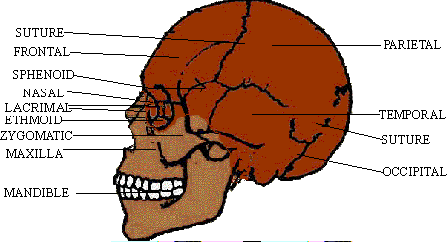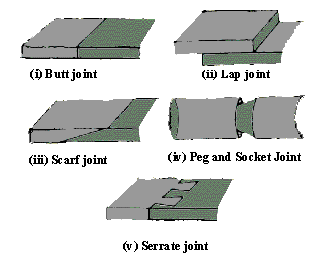A joint is that part of the endoskeleton where
two or more bones meet. Joints between bones are classified into
three main types on the basis of both structure and function,
though these are, of course, related.
(A) Fibrous or Immovable Joints (Synarthrosis)
This includes all immovable joints in which the
bones are united by a thin or dense layer of fibrous tissue. The
cracks between the bones are called sutures (Figure 21.1).
These joints are places of growth and remain open till the growth
period is over, after which they tend to ossify. (Most sutures in
marsupials remain open for life).

Click here for enlargement
Figure 21.1 Sutures of Skull
As per the configuration of the sutures, the following
sub-types are present (Figure 21.2).
(i) Butt joint. Sutures are straight or
have squared off edges. Butt joints can withstand compression, but
not shear or bending. (e.g., two nasal bones).
(ii) Lap joint. When the squared edges of
bones overlap, it forms the lap joint. Lap joints are stronger,
and unusual in animals.
(iii) Scarf joint. If the overlapping edges
taper so that the two bones remain in line, it is called a scarf
joint. This kind of a joint improves strength. (e.g. various skull
bones).

Figure 21.2 Subtypes of fibrous joints
(iv) Peg and socket joint. Small projections
are formed in one bone which fits into another bone. (e.g., thecodont
teeth to the jaw bones, epiphysis of long bones to their shafts).
(v) Serrate joint. The bones have irregular
suture, so the bones interlock repeatedly through the union. (e.g.,
roofing bones of the skull).
(B) Cartilaginous or Slightly Movable Joints (Amphiarthriosis)
In this joint, the adjoining bony surfaces are
connected by cartilage. It is a tough joint and allows some motion
in response to compression, tension or twisting.
(i) The union between the bones of such
a joint is called a symphysis instead of a suture (Figure
21.3 A) (e.g., pelvic symphysis between pubis and pelvis, madibular
symphysis, and vertebral centra, which provide for motions of the
spine). The pubic symphysis is more flexible in women under the
hormonal environment during pregnancy; this is needed for childbirth,
to enable the birth canal to enlarge.